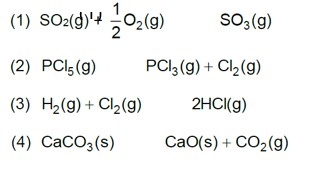7.22. Bromine monochloride (BrCl) decomposes into bromine and chlorine and reaches the equilibrium:
2BrCl (g) ⇌ Br2 (g) + Cl2 (g)
The value of Kc is 32 at 500 K. If initially pure BrCl is present at a concentration of 3.3 x10-3mol L-1, what is its molar concentration in the mixture at equilibrium?
7.22. Bromine monochloride (BrCl) decomposes into bromine and chlorine and reaches the equilibrium:
2BrCl (g) ⇌ Br2 (g) + Cl2 (g)
The value of Kc is 32 at 500 K. If initially pure BrCl is present at a concentration of 3.3 x10-3mol L-1, what is its molar concentration in the mixture at equilibrium?
-
1 Answer
-
Let x moles of BrCl decompose in order to attain the equilibrium. The initial molar concentration and the molar concentration at equilibrium point of different species may be represented as follows:
2BrCl2?(g) ?→?Ar2?(g)+Cl2?(g)3.3×10−3m 0 0
3.3×10−3−2αα? α
∴ Kc?= (α×α)? /(3.3×10−3−2α)2
⇒ α2 / (3.3×10−3
...more
Similar Questions for you
0.01 M NaOH,
M = 1 * 10-2

pOH = 2
pH = 2
Kp = Kc (RT)Dng
36 * 10–2 = Kc (0.0821 * 300)–1
Kc = 0.36 * 0.0821 * 300 = 8.86 » 9
A(g) ->B(g) + (g)
Initial moles n 0 0
Eqb. moles n(1 – a) na
total moles =
Eqb. pressure
On increasing pressure, equilibrium moves in that direction where number of gaseous moles decreases.
Taking an Exam? Selecting a College?
Get authentic answers from experts, students and alumni that you won't find anywhere else
Sign Up on ShikshaOn Shiksha, get access to
- 65k Colleges
- 1.2k Exams
- 679k Reviews
- 1800k Answers


